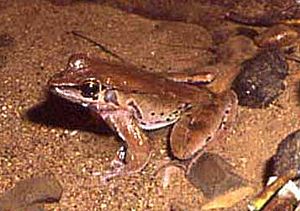Sylvirana cubitalis facts for kids
Quick facts for kids Sylvirana cubitalis |
|
|---|---|
 |
|
| Conservation status | |
| Scientific classification | |
| Synonyms | |
|
The Siam frog (Sylvirana cubitalis) is a small amphibian. It is also known by other names like the Siamese frog, yellow stream frog, darkeared frog, or black-eared frog. These frogs live in parts of Asia, including China, Thailand, Vietnam, and Laos.
Contents
About the Siam Frog
Siam frogs are a type of frog that belongs to the Sylvirana group. This group includes many frogs that live near water. Frogs are amphibians, which means they can live both in water and on land. They have smooth, moist skin.
What Does It Look Like?
The Siam frog is usually small to medium-sized. Its skin color can vary, often blending in with its surroundings. Some frogs in this group have a yellowish tint, which is why they are sometimes called "yellow stream frogs." The "darkeared" or "black-eared" names suggest they might have dark spots near their ears.
Frogs have strong back legs. These legs help them jump far and quickly. They also have webbed feet. Webbed feet are great for swimming in water. Their eyes are usually on top of their heads. This helps them see above the water while most of their body stays hidden.
Where Does It Live?
Siam frogs prefer to live near water. You can often find them in or around streams, rivers, and ponds. They like places with lots of plants. These plants help them hide from animals that might want to eat them. They are found in tropical and subtropical areas of Asia. These areas have warm temperatures and plenty of rain.
What Does It Eat?
Like most frogs, the Siam frog is a carnivore. This means it eats other animals. They mostly eat small insects. They use their long, sticky tongues to catch their prey. When an insect flies or crawls by, the frog quickly flicks out its tongue. The insect sticks to the tongue and is pulled into the frog's mouth.
Some of the insects they might eat include:
- Flies
- Mosquitoes
- Beetles
- Spiders
Life Cycle
The life cycle of the Siam frog is similar to other frogs. It starts with eggs.
- Eggs: Female frogs lay their eggs in water. The eggs are usually in a jelly-like mass.
- Tadpoles: After a few days or weeks, the eggs hatch into tadpoles. Tadpoles live completely in water. They breathe using gills, like fish. They eat tiny plants and algae in the water.
- Metamorphosis: As tadpoles grow, they start to change. This change is called metamorphosis. They grow back legs first, then front legs. Their tails get shorter. Their gills disappear, and they develop lungs to breathe air.
- Adult Frog: Once the metamorphosis is complete, the tadpole becomes a small frog. It can now live on land and in water. The young frog will continue to grow until it reaches its full adult size. Adult frogs then find mates and lay their own eggs, starting the cycle again.
Importance in Nature
Frogs play an important role in their ecosystem. They help control insect populations. By eating many insects, they prevent too many insects from growing. They are also a food source for other animals. Birds, snakes, and larger animals might eat frogs. This makes them a key part of the food chain.
See also
 In Spanish: Sylvirana cubitalis para niños
In Spanish: Sylvirana cubitalis para niños


